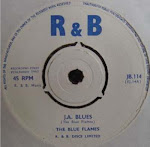
Once again it is difficult to unravel the original elements that went into what was to become the « Swinging London » style. For one thing it all happened fairly fast, but most important is the way that in pop slang a word, in this case ‘mod’, changes its meaning to accommodate a rapidly changing situation.
Initially for instance ‘mod’ meant a very small group of young working-class boys who, at the height of the trad boom, formed a small totally committed little mutual admiration society devoted to clothes.
There was no sense amongst the first Mods of using clothes as a form of aggression as the Teds had. They didn’t want to fight or screw or smash anything. They were true dandies, interested in creating works of art – themselves. There had of course been dandies before but they’d always been upper-class dandies.
Now Macmillan’s affluence had helped create working-class dandies-dedicated followers of fashion.
There was admittedly a strong homosexual element involved – but it was not so much overt homosexuality as narcissistic. Girls were irrelevant. The little Mods used each other as looking glasses. They were as cool as ice-cubes.
The originals Mods had their clothes made, hunting down tailors and shoe-makers prepared to bend to their fantasies or, if they did admit something mass-produced they either modified it, took it out of context or insisted on certain stringent qualifications – their jeans, for instance, had to be American.
But the main thing about the first Mods was that they were true purists. Clothes were their only interest, but at the same time, in that they were the forerunners of a general trend, they carried with them their own destruction. As the ‘mod’ thing spread it lost its purity. For the next generation of Mods, those who picked up the ‘mod’ thing around 1963, clothes, while still their central preoccupation, weren’t enough. They needed music (Rhythm and Blues), transport (scooters) and drugs (pep pills).
What’s more they needed fashion ready-made. They hadn’t the time or the fanaticism to invent new styles, and this is where Carnaby Street came in.
John Stephen, a Scotsman, had opened his first shop for men in London in 1957, only a year after Quant’s first Bazaar. He’d done well but had attracted little general attention outside rather specialist circles. The point was that throughout the late 50s and early 60s any male fashion beyond John Michael’s discreet splendour or Cecil Gee’s continental ‘casual’ look tended to cater almost exclusively for butch trade.
I have for instance in my files a catalogue advertising an avant-garde men’s shop of the very early 60s which illustrates its collection in story form. The tale is simple. A young man called Ted is picked up by a lean mature film director called Lance en route to the South of France. Their relationship is underplayed, but their clothes are described in almost pornographic detail. ‘Ted’, reads one extract, ‘is open to all offers so make your bids now for this season’s slant on denim.’ Finally wearing ‘Tickling slax; slim cut thigh huggers at £3 9s 6d’, Ted decides to extend his holiday with Lance by accompanying him to Rome… ‘so take care Nero – they’re on their way’ is the sign-off line.
The growth of shops of this kind meant that when the ‘mod’ thing happened very little adjustment was necessary. Shepherd’s Bush, the main launching-pad for the blast-off stage in the Mod explosion, discovered Stephen and put Carnaby Street on the map. In no time at all Soho at week-ends was full of Mods piled up to the eyebrows, dressed like kaleidoscopes, and bouncing in and out of cellar clubs like yoyos.
George Melly – Revolt Into Style --- To be continued




No comments:
Post a Comment